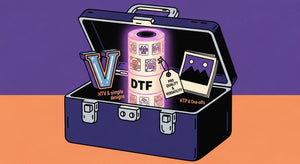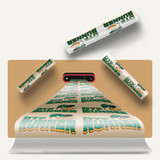Table of Contents
- What is DTF Printing?
- Importance of Choosing the Right Heat Press
- Types of Heat Presses for DTF Transfers
- Key Features to Look for in a Heat Press for DTF Transfers
- Popular Heat Press Models for DTF Transfers
- How to Maintain Your Heat Press
- Tips for Successful DTF Transfers
- Enhancing Your Promotional Products with DTF Transfer
- Advanced DTF Printing Techniques
- Common Challenges and How to Overcome Them
- Future Trends in DTF Printing
- Page Speed Optimization and Mobile Friendliness
- Right Heat Press for DTF Transfers
Heat press machines are just one of the crucial gadgets you must have when it comes to DTF printing. Your ideal heat press ensures that your DTF transfers bond perfectly to your chosen substrates, resulting in high-quality and durable prints. This guide will take you through how to select the right heat press for your DTF printing so that your products look professional and last.
What is DTF Printing?
DTF (direct-to-film) printing is a versatile printing method that allows you to print designs onto a special film and then transfer them onto various materials using a heat press. This technique is gaining popularity due to its ability to produce vibrant, detailed, and durable prints. For successful DTF transfers, having the right heat press is essential, we recommend that you take due care.
Importance of Choosing the Right Heat Press
Selecting the right heat press is crucial for the quality and efficiency of your DTF printing. An appropriate heat press will provide consistent temperature and pressure, essential for achieving a strong bond between the DTF transfer and the fabric. Here are the main factors to consider:
- Temperature Consistency: Accurate and consistent temperature is vital for proper adhesion.
- Pressure Control: Even pressure ensures the transfer adheres evenly without gaps or bubbles.
- Size and Compatibility: The heat press should match the size of your transfers and be compatible with various substrates.
Types of Heat Presses for DTF Transfers
Some of the various types of heat presses that can be used in DTF printing are as follows:
1. Clamshell Heat Press
The clamshell heat press is a popular choice due to its simplicity and compact design. It opens and closes like a clamshell, making it easy to operate.
- Pros: Space-saving, user-friendly, and generally less expensive.
- Cons: Limited pressure adjustment and can be difficult to position transfers accurately.
2. Swing-Away Heat Press
The swing-away heat press has a platen that swings away from the base, allowing for easier access to the working area.
- Pros: Provides even pressure, better access for positioning transfers, and safer operation.
- Cons: Requires more space and is typically more expensive.
3. Draw Heat Press
The draw press has a lower platen that pulls out like a drawer, providing about the same benefits as the swing-away for access.
- Pros: Easier transfer positioning and even pressure distribution.
- Cons: More complex mechanism and higher cost.

Key Features to Look for in a Heat Press for DTF Transfers
When selecting a heat press for your DTF printing needs, consider the following features:
1. Temperature Range and Stability
The heat press should offer a wide temperature range, typically between 0-250°C (32-482°F), and maintain stable temperatures. Stability ensures consistent results across multiple prints.
2. Pressure Adjustment
Adjustable pressure settings are crucial for different substrates and transfer types. A heat press with a pressure gauge or easy adjustment mechanism is ideal.
3. Platen Size
Choose a platen size that matches your DTF transfer needs. Common sizes range from 15x15 inches to 16x20 inches. Larger platens allow for bigger transfers but may require more space.
4. Digital Controls
Digital controls for temperature and time settings provide precision and ease of use. They help maintain consistent settings for different print jobs.
5. Build Quality and Durability
Invest in a high-quality, high-quality built, high-quality built heat press created from materials able to endure off time yet stay strong and work efficiently.
6. Safety Features
Look for safety features such as automatic shut-off, overheat protection, and sturdy handles to prevent accidents during operation.
Popular Heat Press Models for DTF Transfers
Here are some highly recommended heat press models for DTF printing:
PowerPress Industrial-Quality Heat Press
- Features: Digital controls, adjustable pressure, and a 15x15-inch platen.
- Pros: Reliable performance and affordable pricing.
- Cons: The clamshell design may limit transfer positioning.
Fancierstudio Power Heat Press
- Features: Swing-away design, digital controls, and a 16x20-inch platen.
- Pros: Even pressure distribution and spacious working area.
- Cons: Requires more space and higher price point.
Cricut EasyPress 2
- Features: Portable design, precise temperature control, and various sizes.
- Pros: Ideal for small projects and easy to use.
- Cons: Limited pressure adjustment and smaller platen sizes.

How to Maintain Your Heat Press
Proper maintenance of your heat press ensures longevity and consistent performance. Here are some maintenance tips:
1. Regular Cleaning
Clean the platen regularly to remove any adhesive residue or ink. Use a soft cloth and mild cleaner to avoid damaging the surface.
2. Check for Wear and Tear
Inspect the heat press machine for any damages or wear, including screws that may be loose and worn parts. Attend to problems as quickly as they occur to avoid more apparent damage.
3. Calibration
Periodically, it is always important to verify the calibration of settings for both temperature and pressure; do this by referring to settings with the help of a thermometer and a pressure gauge.
4. Lubrication
Lubricate moving parts, such as hinges and joints, to ensure smooth operation. Use a lubricant recommended by the manufacturer.
Tips for Successful DTF Transfers
To achieve the best results with your DTF transfers, follow these tips:
1. Preheat the Substrate
Preheating the fabric helps remove moisture and wrinkles, ensuring better adhesion of the transfer.
2. Use Quality Transfers
Invest in high-quality DTF transfers to achieve vibrant and durable prints. Look for reputable suppliers to buy your DTF transfers.
3. Test Settings
Before running a big batch, verify the temperature, pressure, and timing setup on a sample fabric to get good results.
4. Peel Carefully
Follow the manufacturer's instructions for peeling the film. Some transfers require hot peeling, while others need to cool before peeling.
Enhancing Your Promotional Products with DTF Transfer
DTF printing allows for creativity and customization in your promotional products. Here are some ideas to make your items stand out:
- Custom T-Shirts: Create unique designs for events, giveaways, or team uniforms.
- Branded Bags: Print logos and slogans on tote bags for eco-friendly marketing.
- Personalized Hats: Design caps with intricate patterns or logos for stylish promotion.
- Event Merchandise: Offer custom-printed items at trade shows, conferences, or festivals.
It can certainly add more depth and some unique ideas for your promotional items if you use DTF printing in combination with techniques like embroidery or screen printing.
Advanced DTF Printing Techniques
Once you’re comfortable with the basics of DTF printing, you can explore advanced techniques to enhance your promotional products further:
- Layering and Special Effects: Experiment with layering different colors and using special effect powders for unique textures and finishes.
- Customizable Designs: Offer customers the option to personalize their items with names, dates, or custom messages.
- Combining Printing Methods: Mix DTF printing with other methods like sublimation or screen printing to create multifaceted designs.
These are techniques that can aid you in creating a final promotional product that stands out to grab attention and provides a lasting impression.
Common Challenges and How to Overcome Them
DTF printing can present some challenges. Here are common issues and how to address them:
- Ink Spread or Bleeding: Ensure you use the correct printer settings and high-quality film.
- Incomplete Transfers: Check that your heat press is providing consistent temperature and pressure.
- Adhesion Problems: Make sure you’re applying the transfer powder evenly and curing it properly.
Regularly reviewing and adjusting your process can help you troubleshoot and prevent these issues, ensuring consistent, high-quality results.
Future Trends in DTF Printing
DTF printing is a very versatile field in which day-to-day emerging technologies and trends play an important role. Some of the current trends are as follows:
- Eco-Friendly Materials: Expect to see more eco-friendly films and inks as sustainability becomes increasingly important.
- Improved Equipment: Advances in DTF printing equipment will continue to enhance print quality and efficiency.
- Expanded Applications: DTF printing is likely to expand beyond textiles into other promotional items like mugs, phone cases, and more.
The ability to keep up with new trends and techniques is going to allow you to polish, ever better your DTF printing process, ensuring that your promotional products do nothing but stay on top of the competition. It is very important to capture the spirit of the period well in order to do a good job.
Page Speed Optimization and Mobile Friendliness
We would like to make a few suggestions about your website where you sell products. In today’s digital age, ensuring your content is optimized for both page speed and mobile friendliness is crucial. Here are some tips:
- Optimize Images: Compress and resize images to reduce load times.
- Minimize HTTP Requests: Reduce the number of elements on your page.
- Use Lazy Loading: Implement lazy loading for images and videos to improve initial load times.
- Enable Browser Caching: Store static resources in the user’s browser to speed up subsequent visits.
- Ensure Mobile Responsiveness: Use responsive design techniques to ensure your content looks great on all devices.
By following these tips, you can enhance the user experience on your website, leading to better engagement and higher conversion rates.
Right Heat Press for DTF Transfers
In choosing, focus on selecting the right equipment for your DTF printing needs. Go into detail regarding the dimensions of the platen, from temperature stability to the maneuverability in pressure, and platen size; these are some of the factors that you should consider when buying. And don't forget that you should take good care of your heat press so that it doesn't let you down in the future.
Suppose you have anything to do with DTF printing and you want to buy DTF transfers, make sure that you have a reliable and effective heat press. With effective equipment and methods, you can surprise your audience with breathtaking promotional products for a very long time. We are sure that by following the suggestions above, you will achieve successful work in a short time. Wish you good luck. Happy Printing!






